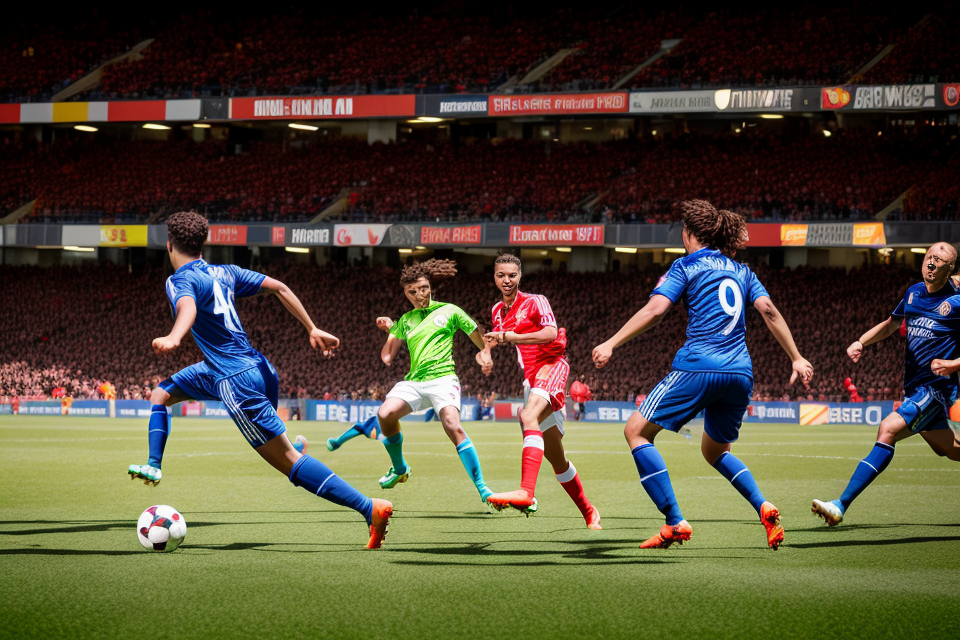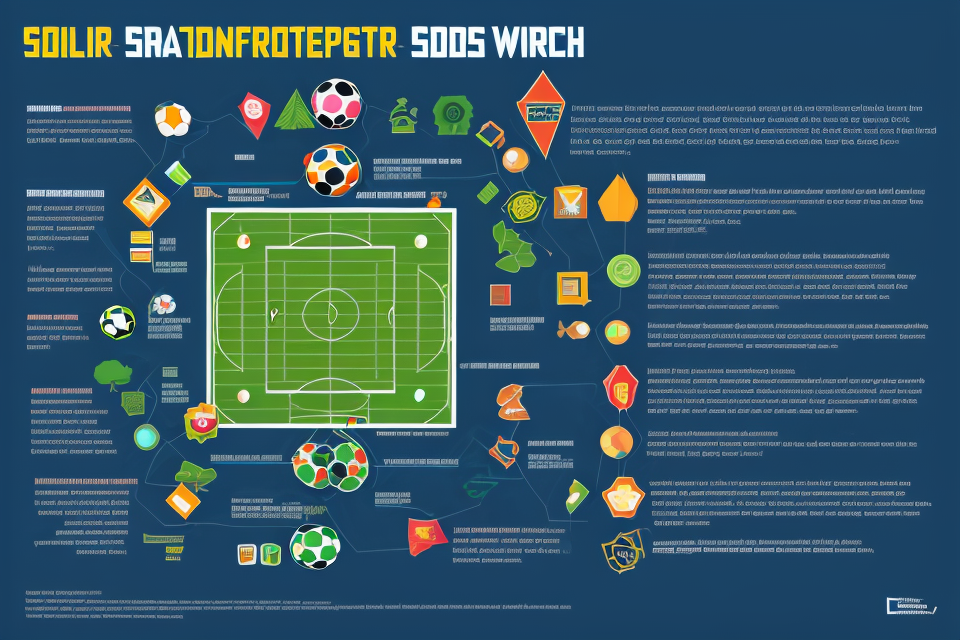Soccer is a game of strategy and tactics, with both being crucial elements for success on the field. While many people use the terms “tactics” and “strategy” interchangeably, they actually refer to two distinct concepts. Tactics are the specific actions and movements a team or player uses during a game, while strategy refers to the overall plan and approach that guides those tactics. In other words, tactics are the means, while strategy is the end. In this article, we’ll explore the difference between tactics and strategy in soccer, and how understanding this difference can help you improve your game.
In soccer, tactics refer to the specific actions and plans that a team or individual player uses during a match to achieve their goals. This can include things like forming certain formations on the field, making certain plays, or using certain defensive or offensive strategies. Strategy, on the other hand, refers to the overall plan or approach that a team or player uses to achieve their goals over the course of a season or longer period of time. This can include things like deciding which players to use in certain positions, developing certain training programs, or identifying key opponents. Tactics are focused on the short-term actions needed to win a match, while strategy is focused on the long-term goals and objectives of the team or player.
Understanding Tactics in Soccer
The Importance of Tactics in Soccer
Tactics in soccer refer to the specific actions and movements that players make on the field in order to achieve a particular goal or objective. These actions can include things like passing, dribbling, shooting, and defending. Tactics are essential to the success of any soccer team because they help players to work together effectively and achieve their goals.
There are several key aspects of tactics in soccer that are important to understand. These include:
- Formation: The formation of a team refers to the way that players are arranged on the field. Different formations can be used to achieve different objectives, such as controlling the ball or defending against opponents.
- Positioning: Positioning refers to where players are located on the field at any given time. Effective positioning is essential for players to be in the right place to make a successful play.
- Possession: Possession refers to the amount of time that a team has control of the ball. Teams that are able to maintain possession are often more successful because they are able to control the flow of the game.
- Transitions: Transitions refer to the way that a team moves from defense to offense or vice versa. Effective transitions can help a team to quickly switch between playing defense and playing offense.
Overall, tactics are an essential part of soccer because they help players to work together effectively and achieve their goals on the field.
Types of Tactics in Soccer
Soccer is a complex and strategic game that requires a deep understanding of tactics and strategies. Tactics refer to the specific actions and plans that a team employs during a match, while strategy refers to the overall plan and approach that a team uses to achieve their goals. In this section, we will delve into the different types of tactics in soccer.
Defensive Tactics
Defensive tactics refer to the actions and plans that a team employs to prevent the opposing team from scoring. Some common defensive tactics include:
- Zonal Marking: This tactic involves assigning specific areas of the field to individual defenders, who then work together to track the opposing team’s forwards and prevent them from receiving the ball.
- Man-to-Man Marking: This tactic involves assigning a specific defender to mark a specific opposing player, with the goal of preventing that player from receiving the ball or scoring.
- Offside Trap: This tactic involves placing a defender close to the opposing team’s forward in an attempt to anticipate and intercept a pass, with the goal of gaining possession of the ball.
Offensive Tactics
Offensive tactics refer to the actions and plans that a team employs to score goals. Some common offensive tactics include:
- Short Passing: This tactic involves passing the ball quickly and accurately among teammates, with the goal of moving the ball up the field and creating scoring opportunities.
- Long Ball: This tactic involves passing the ball long distances, with the goal of bypassing the opposing team’s midfielders and attacking the opposing team’s goal directly.
- Wing Play: This tactic involves using the wide positions on the field to create space and opportunities for attacking players, with the goal of crossing the ball into the opposing team’s box and scoring.
Transition Tactics
Transition tactics refer to the actions and plans that a team employs to transition from defense to offense or vice versa. Some common transition tactics include:
- Counter-Attacking: This tactic involves quickly transitioning from defense to offense, with the goal of catching the opposing team off guard and creating scoring opportunities.
- Pressing: This tactic involves aggressively pursuing the opposing team’s players when they have possession of the ball, with the goal of winning the ball back and transitioning to offense.
- Switching Play: This tactic involves quickly changing the direction of the attack, with the goal of catching the opposing team off guard and creating scoring opportunities.
Understanding these different types of tactics is crucial for any soccer player or coach looking to improve their team’s performance on the field. By mastering these tactics, teams can gain a significant advantage over their opponents and increase their chances of winning matches.
Common Tactics Used by Teams
In soccer, tactics refer to the specific actions and strategies employed by teams during a match. These tactics can range from formations and marking systems to set pieces and transition play. In this section, we will explore some of the most common tactics used by teams in soccer.
4-4-2 Formation
The 4-4-2 formation is one of the most widely used formations in soccer. It involves four defenders, four midfielders, and two strikers. This formation is known for its balance and flexibility, as it allows teams to maintain a strong defensive shape while also providing plenty of attacking options. The two strikers typically play up front, with one serving as a target man and the other as a more mobile and technically gifted player. The midfielders in a 4-4-2 formation often play narrow, providing support to the strikers and helping to create space for the fullbacks to overlap.
3-5-2 Formation
The 3-5-2 formation is another popular tactic used by teams in soccer. This formation involves three central defenders, five midfielders, and two strikers. The three central defenders provide a strong defensive base, while the five midfielders help to control the midfield and support the attack. The two strikers in a 3-5-2 formation often play narrower than in a traditional 4-4-2 formation, allowing the fullbacks to push forward and provide width.
Zonal Marking
Zonal marking is a tactical system used by teams in soccer. In this system, each player is assigned a specific zone on the field to defend, rather than being assigned to a specific opponent. This allows teams to maintain a more organized defensive shape and prevent opponents from finding pockets of space. Zonal marking is often used in conjunction with a high defensive line, as it allows teams to pressure opponents higher up the field and prevent them from playing through the middle.
Man-to-Man Marking
Man-to-man marking is a tactical system used by teams in soccer. In this system, each player is assigned a specific opponent to mark. This allows teams to provide tight coverage of dangerous attacking players and prevent them from receiving the ball. Man-to-man marking is often used in conjunction with a low defensive line, as it allows teams to drop off and defend in numbers, making it more difficult for opponents to break through.
In conclusion, tactics in soccer refer to the specific actions and strategies employed by teams during a match. Common tactics used by teams include the 4-4-2 and 3-5-2 formations, zonal marking, and man-to-man marking. Each of these tactics has its own strengths and weaknesses, and teams must carefully consider which tactics to use based on their own strengths and weaknesses, as well as the strengths and weaknesses of their opponents.
Understanding Strategy in Soccer
The Importance of Strategy in Soccer
Strategy in soccer refers to the overall plan and approach that a team adopts in order to achieve their goals on the field. It encompasses all aspects of the game, from the way players position themselves on the field to the tactics they use to outmaneuver their opponents. A well-designed strategy can give a team a significant advantage over their opponents, as it allows them to anticipate and respond to the other team’s moves more effectively.
There are several key aspects of strategy in soccer that are crucial to a team’s success. These include:
- Formation: The way that players are arranged on the field can have a major impact on the game. Different formations offer different advantages, such as greater defensive strength or more attacking power.
- Tactics: The specific moves and plays that a team uses to gain an advantage over their opponents. These can include things like short passing, long balls, and quick movements off the ball.
- Player roles: Each player on the field has a specific role to play in the team’s strategy. Understanding these roles and how they fit together is essential to executing a successful strategy.
- Game plan: The overall plan for the game, including how the team will approach attacking and defending, and how they will use their players to achieve their goals.
In addition to these aspects, strategy in soccer also involves making tactical decisions in response to the other team’s moves. This can include adjusting the team’s formation or tactics, or making substitutions to bring on fresh players.
Overall, the importance of strategy in soccer cannot be overstated. A well-designed strategy can give a team a significant advantage over their opponents, and can help them to achieve their goals on the field.
Types of Strategy in Soccer
Soccer is a complex sport that requires both tactics and strategy to be successful. Strategy is the overall plan or approach that a team takes to achieve their goals on the field. It involves making decisions about how to use the team’s resources, such as players, ball possession, and time, to achieve a desired outcome. There are several types of strategy in soccer, each with its own unique characteristics and goals.
Short-term strategy
Short-term strategy is a tactical approach that is designed to help a team gain immediate control of the game. This type of strategy is often used when a team is behind or needs to prevent the other team from scoring. Examples of short-term strategies include pressing, defending, and counter-attacking.
Long-term strategy
Long-term strategy is a more broad approach that is designed to help a team achieve their goals over the course of the entire game. This type of strategy involves making decisions about how to use the team’s resources to gain a competitive advantage over the other team. Examples of long-term strategies include ball possession, formation, and player positioning.
Game-changing strategy
Game-changing strategy is a type of strategy that is designed to turn the game in a team’s favor. This type of strategy is often used when a team is losing or needs to make a significant change in the game. Examples of game-changing strategies include substitutions, set pieces, and tactical changes.
Overall, the type of strategy that a team uses will depend on their goals, strengths, and weaknesses. A successful team will be able to adapt their strategy throughout the game based on the changing circumstances on the field.
Common Strategies Used by Teams
Soccer is a complex game that requires a lot of planning and strategy to be successful. Teams employ various tactics and strategies to outsmart their opponents and achieve their goals. In this section, we will discuss some of the most common strategies used by teams in soccer.
Pressing
Pressing is a strategy used by teams to win the ball back as quickly as possible after losing it. This tactic involves putting pressure on the opponent with the ball, trying to force them to make a mistake or lose possession. Pressing can be done by any player on the field, but it is usually done by the forwards and midfielders.
The goal of pressing is to disrupt the opponent’s rhythm and create turnovers that can lead to scoring opportunities. When done effectively, pressing can be a very effective strategy for winning games. However, it also requires a lot of energy and discipline, as players need to stay focused and work together to apply pressure without leaving gaps in the defense.
Possession-based strategy
A possession-based strategy is a tactical approach that emphasizes keeping the ball and controlling the game. This strategy involves passing the ball around and moving off the ball to create space and opportunities for scoring.
Teams that use a possession-based strategy typically have a lot of ball control and try to slow down the game by keeping the ball away from their opponents. They may also use short passes and movement off the ball to create openings and break down the opponent’s defense.
The goal of a possession-based strategy is to tire out the opponent and create scoring opportunities through sustained pressure. However, it also requires a lot of discipline and patience, as teams need to be able to maintain possession even when under pressure.
Counter-attacking strategy
A counter-attacking strategy is a tactical approach that involves launching quick attacks after winning the ball back. This strategy is often used by teams that are not as skilled or physically fit as their opponents, as it allows them to catch their opponents off guard and take advantage of their weaknesses.
Teams that use a counter-attacking strategy typically have fast and agile players who can quickly transition from defense to offense. They may also use long balls and direct attacks to catch their opponents off guard and create scoring opportunities.
The goal of a counter-attacking strategy is to catch the opponent off guard and take advantage of their mistakes. However, it also requires a lot of discipline and focus, as teams need to be able to defend well and quickly transition to offense when the opportunity arises.
Strategy vs. Tactics
In soccer, strategy and tactics are often used interchangeably, but they actually refer to different aspects of the game. Strategy refers to the overall plan and approach that a team takes, while tactics refer to the specific actions and techniques used to execute that plan.
Here are some key differences between strategy and tactics in soccer:
- Strategy is the overall plan and approach that a team takes. It involves decision-making, positioning, and the allocation of resources. A team’s strategy should align with its strengths and weaknesses, as well as the strengths and weaknesses of its opponents. A good strategy will also take into account the specific conditions of the game, such as the weather, the field conditions, and the injuries or absences of key players.
- Tactics are the specific actions and techniques used to execute a team’s strategy. Tactics involve the movement of players, the use of formations, and the timing of attacks or defenses. Tactics are usually more focused on the immediate actions of the players on the field, and they can change more frequently during the course of a game.
When deciding whether to use tactics or strategy, it’s important to consider the situation at hand. For example, if a team is losing and needs to make a quick change to turn the game around, it may be more useful to focus on tactics. On the other hand, if a team is winning and wants to maintain its lead, it may be more useful to focus on strategy.
Ultimately, both strategy and tactics are important in soccer, and a successful team will need to use both effectively in order to win games. A good coach will be able to balance the use of strategy and tactics based on the specific circumstances of each game.
Tactics vs. Strategy: Which is More Important?
Factors That Determine the Importance of Tactics vs. Strategy
- The strengths and weaknesses of the team: A team’s strengths and weaknesses play a crucial role in determining the importance of tactics versus strategy. For instance, if a team has a strong defense but a weak attack, the coach may place more emphasis on tactics to improve the team’s attacking play. On the other hand, if a team has a strong attack but weak defense, the coach may focus more on strategy to shore up the defense.
- The opposing team’s strengths and weaknesses: The strengths and weaknesses of the opposing team also influence the importance of tactics versus strategy. If the opposing team has a strong defense, the coach may focus on tactics to find ways to break through the defense. If the opposing team has a weak defense, the coach may focus more on strategy to exploit the weaknesses in the opposing team’s defense.
- The specific game situation: The specific game situation can also impact the importance of tactics versus strategy. For example, if a team is trailing late in the game, the coach may focus more on tactics to find a way to score a goal. On the other hand, if a team is leading late in the game, the coach may focus more on strategy to protect the lead.
The Role of the Coach
In soccer, the coach plays a crucial role in determining the success of a team. The coach is responsible for creating and implementing tactics and strategies that will help the team achieve its goals. However, the role of the coach goes beyond just developing tactics and strategies.
One of the key responsibilities of the coach is to adapt tactics and strategies to the game situation. This means that the coach must be able to make changes to the team’s tactics and strategies during the game based on the current situation. For example, if the team is behind, the coach may decide to change the team’s formation or tactics to try and equalize the score.
Another important role of the coach is to motivate the team. A coach must be able to inspire and motivate players to perform at their best. This can involve providing positive feedback, encouraging players to take risks, and creating a positive team culture.
Furthermore, the coach must also be able to manage the team’s emotions and ensure that players remain focused and disciplined throughout the game. This can involve making substitutions at appropriate times, controlling the team’s tempo, and ensuring that players are aware of their roles and responsibilities within the team.
Overall, the role of the coach in soccer is multifaceted and complex. A successful coach must be able to develop effective tactics and strategies, adapt to changing game situations, motivate players, and manage the team’s emotions. These skills are essential for any coach who wants to lead a successful soccer team.
FAQs
1. What is the difference between tactics and strategy in soccer?
Tactics refer to the specific plans and actions that a team or player uses during a match to achieve their goals. This can include formations, positioning, and individual plays. Strategy, on the other hand, refers to the overall plan or approach that a team or coach uses to achieve their goals over the course of a season or longer period. It encompasses the tactics used in individual matches, as well as other factors such as player development, injury management, and opponent analysis.
2. Is it more important to have good tactics or good strategy in soccer?
Both tactics and strategy are important in soccer, and a successful team will have a good balance between the two. Good tactics can help a team win individual matches, while good strategy can help a team achieve their goals over the long term. However, having good tactics without a solid overall strategy can lead to a team being inconsistent or unable to adapt to changing circumstances.
3. Can a team have good tactics but poor strategy?
Yes, it is possible for a team to have good tactics but poor strategy. For example, a team may have a strong formation or set of plays that they use effectively, but if they don’t have a clear plan for how to achieve their goals over the course of a season or longer period, they may struggle to consistently perform at a high level. A good strategy should encompass not only the tactics used in individual matches, but also other factors such as player development, injury management, and opponent analysis.
4. How do coaches develop good tactics and strategy in soccer?
Coaches can develop good tactics and strategy in soccer by studying the game, analyzing opponents, and experimenting with different approaches. They can also learn from the successes and failures of other teams and coaches, and seek out guidance from experienced mentors. Additionally, a coach must be able to effectively communicate their plans and expectations to their players, and adapt their tactics and strategy as needed based on the strengths and weaknesses of their team.



